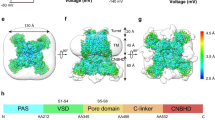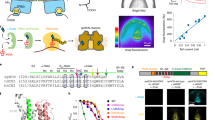Abstract
Voltage-sensor domains couple membrane potential to conformational changes in voltage-gated ion channels and phosphatases. Highly coevolved acidic and aromatic side chains assist the transfer of cationic side chains across the transmembrane electric field during voltage sensing. We investigated the functional contribution of negative electrostatic potentials from these residues to channel gating and voltage sensing with unnatural amino acid mutagenesis, electrophysiology, voltage-clamp fluorometry and ab initio calculations. The data show that neutralization of two conserved acidic side chains in transmembrane segments S2 and S3, namely Glu293 and Asp316 in Shaker potassium channels, has little functional effect on conductance-voltage relationships, although Glu293 appears to catalyze S4 movement. Our results suggest that neither Glu293 nor Asp316 engages in electrostatic state–dependent charge-charge interactions with S4, likely because they occupy, and possibly help create, a water-filled vestibule.
This is a preview of subscription content, access via your institution
Access options
Subscribe to this journal
Receive 12 print issues and online access
$259.00 per year
only $21.58 per issue
Buy this article
- Purchase on Springer Link
- Instant access to full article PDF
Prices may be subject to local taxes which are calculated during checkout





Similar content being viewed by others
References
Hille, B. Ion Channels of Excitable Membranes 3rd edn. (Sinauer, 2001).
Murata, Y., Iwasaki, H., Sasaki, M., Inaba, K. & Okamura, Y. Phosphoinositide phosphatase activity coupled to an intrinsic voltage sensor. Nature 435, 1239–1243 (2005).
Ramsey, I.S., Moran, M.M., Chong, J.A. & Clapham, D.E. A voltage-gated proton-selective channel lacking the pore domain. Nature 440, 1213–1216 (2006).
Ahern, C.A. & Horn, R. Focused electric field across the voltage sensor of potassium channels. Neuron 48, 25–29 (2005).
Aggarwal, S.K. & MacKinnon, R. Contribution of the S4 segment to gating charge in the Shaker K+ channel. Neuron 16, 1169–1177 (1996).
Seoh, S.A., Sigg, D., Papazian, D.M. & Bezanilla, F. Voltage-sensing residues in the S2 and S4 segments of the Shaker K+ channel. Neuron 16, 1159–1167 (1996).
Yang, N., George, A.L. Jr. & Horn, R. Molecular basis of charge movement in voltage-gated sodium channels. Neuron 16, 113–122 (1996).
Ahern, C.A. & Horn, R. Specificity of charge-carrying residues in the voltage sensor of potassium channels. J. Gen. Physiol. 123, 205–216 (2004).
Chanda, B. & Bezanilla, F. A common pathway for charge transport through voltage-sensing domains. Neuron 57, 345–351 (2008).
Krepkiy, D. et al. Structure and hydration of membranes embedded with voltage-sensing domains. Nature 462, 473–479 (2009).
Milescu, M. et al. Interactions between lipids and voltage sensor paddles detected with tarantula toxins. Nat. Struct. Mol. Biol. 16, 1080–1085 (2009).
Schmidt, D., Jiang, Q.X. & MacKinnon, R. Phospholipids and the origin of cationic gating charges in voltage sensors. Nature 444, 775–779 (2006).
Xu, Y., Ramu, Y. & Lu, Z. Removal of phospho-head groups of membrane lipids immobilizes voltage sensors of K+ channels. Nature 451, 826–829 (2008).
Armstrong, C.M. Sodium channels and gating currents. Physiol. Rev. 61, 644–683 (1981).
Bosmans, F., Martin-Eauclaire, M.F. & Swartz, K.J. Deconstructing voltage sensor function and pharmacology in sodium channels. Nature 456, 202–208 (2008).
Catterall, W.A. Ion channel voltage sensors: structure, function, and pathophysiology. Neuron 67, 915–928 (2010).
Li-Smerin, Y., Hackos, D.H. & Swartz, K.J. Alpha-helical structural elements within the voltage-sensing domains of a K+ channel. J. Gen. Physiol. 115, 33–50 (1999).
Wu, D. et al. State-dependent electrostatic interactions of S4 arginines with E1 in S2 during Kv7.1 activation. J. Gen. Physiol. 135, 595–606 (2010).
Long, S.B., Tao, X., Campbell, E.B. & MacKinnon, R. Atomic structure of a voltage-dependent K+ channel in a lipid membrane-like environment. Nature 450, 376–382 (2007).
Tao, X., Lee, A., Limapichat, W., Dougherty, D.A. & MacKinnon, R. A gating charge transfer center in voltage sensors. Science 328, 67–73 (2010).
Papazian, D.M. et al. Electrostatic interactions of S4 voltage sensor in Shaker K+ channel. Neuron 14, 1293–1301 (1995).
Tiwari-Woodruff, S.K., Schulteis, C.T., Mock, A.F. & Papazian, D.M. Electrostatic interactions between transmembrane segments mediate folding of Shaker K+ channel subunits. Biophys. J. 72, 1489–1500 (1997).
Zhang, L. et al. Contribution of hydrophobic and electrostatic interactions to the membrane integration of the Shaker K+ channel voltage sensor domain. Proc. Natl. Acad. Sci. USA 104, 8263–8268 (2007).
Planells-Cases, R., Ferrer-Montiel, A.V., Patten, C.D. & Montal, M. Mutation of conserved negatively charged residues in the S2 and S3 transmembrane segments of a mammalian K+ channel selectively modulates channel gating. Proc. Natl. Acad. Sci. USA 92, 9422–9426 (1995).
DeCaen, P.G., Yarov-Yarovoy, V., Sharp, E.M., Scheuer, T. & Catterall, W.A. Sequential formation of ion pairs during activation of a sodium channel voltage sensor. Proc. Natl. Acad. Sci. USA 106, 22498–22503 (2009).
DeCaen, P.G., Yarov-Yarovoy, V., Zhao, Y., Scheuer, T. & Catterall, W.A. Disulfide locking a sodium channel voltage sensor reveals ion pair formation during activation. Proc. Natl. Acad. Sci. USA 105, 15142–15147 (2008).
Silverman, W.R., Roux, B. & Papazian, D.M. Structural basis of two-stage voltage-dependent activation in K+ channels. Proc. Natl. Acad. Sci. USA 100, 2935–2940 (2003).
Nowak, M.W. et al. In vivo incorporation of unnatural amino acids into ion channels in Xenopus oocyte expression system. Methods Enzymol. 293, 504–529 (1998).
Cashin, A.L., Torrice, M.M., McMenimen, K.A., Lester, H.A. & Dougherty, D.A. Chemical-scale studies on the role of a conserved aspartate in preorganizing the agonist binding site of the nicotinic acetylcholine receptor. Biochemistry 46, 630–639 (2007).
Kelly, T.R. & Kim, M.H. Relative binding affinity of carboxylate and its isosteres: nitro, phosphate, phosphonate, sulfonate and σ-lactone. J. Am. Chem. Soc. 116, 7072–7080 (1994).
Perozo, E., MacKinnon, R., Bezanilla, F. & Stefani, E. Gating currents from a nonconducting mutant reveal open-closed conformations in Shaker K+ channels. Neuron 11, 353–358 (1993).
Cha, A. & Bezanilla, F. Characterizing voltage-dependent conformational changes in the Shaker K+ channel with fluorescence. Neuron 19, 1127–1140 (1997).
Mannuzzu, L.M., Moronne, M.M. & Isacoff, E.Y. Direct physical measure of conformational rearrangement underlying potassium channel gating. Science 271, 213–216 (1996).
Chakrapani, S., Cuello, L.G., Cortes, D.M. & Perozo, E. Structural dynamics of an isolated voltage-sensor domain in a lipid bilayer. Structure 16, 398–409 (2008).
Chen, X., Wang, Q., Ni, F. & Ma, J. Structure of the full-length Shaker potassium channel Kv1.2 by normal-mode-based X-ray crystallographic refinement. Proc. Natl. Acad. Sci. USA 107, 11352–11357 (2010).
Starace, D.M. & Bezanilla, F. Histidine scanning mutagenesis of basic residues of the S4 segment of the Shaker K+ channel. J. Gen. Physiol. 117, 469–490 (2001).
Starace, D.M. & Bezanilla, F. A proton pore in a potassium channel voltage sensor reveals a focused electric field. Nature 427, 548–553 (2004).
Chakrapani, S., Sompornpisut, P., Intharathep, P., Roux, B. & Perozo, E. The activated state of a sodium channel voltage sensor in a membrane environment. Proc. Natl. Acad. Sci. USA 107, 5435–5440 (2010).
Gallivan, J.P. & Dougherty, D.A. A computational study of cation-π interactions vs salt bridges in aqueous media: implications for protein engineering. J. Am. Chem. Soc. 122, 870–874 (2000).
Gallivan, J.P. & Dougherty, D.A. Cation-pi interactions in structural biology. Proc. Natl. Acad. Sci. USA 96, 9459–9464 (1999).
Yifrach, O. & MacKinnon, R. Energetics of pore opening in a voltage-gated K+ channel. Cell 111, 231–239 (2002).
Zhong, W. et al. From ab initio quantum mechanics to molecular neurobiology: a cation-pi binding site in the nicotinic receptor. Proc. Natl. Acad. Sci. USA 95, 12088–12093 (1998).
Sokolov, S., Scheuer, T. & Catterall, W.A. Gating pore current in an inherited ion channelopathy. Nature 446, 76–78 (2007).
Tombola, F., Pathak, M.M., Gorostiza, P. & Isacoff, E.Y. The twisted ion-permeation pathway of a resting voltage-sensing domain. Nature 445, 546–549 (2007).
Jiang, Y. et al. X-ray structure of a voltage-dependent K+ channel. Nature 423, 33–41 (2003).
Jogini, V. & Roux, B. Dynamics of the Kv1.2 voltage-gated K+ channel in a membrane environment. Biophys. J. 93, 3070–3082 (2007).
Sato, Y., Sakaguchi, M., Goshima, S., Nakamura, T. & Uozumi, N. Integration of Shaker-type K+ channel, KAT1, into the endoplasmic reticulum membrane: synergistic insertion of voltage-sensing segments, S3-S4, and independent insertion of pore-forming segments, S5-P-S6. Proc. Natl. Acad. Sci. USA 99, 60–65 (2002).
Lacroix, J.J., Labro, A.J. & Bezanilla, F. Properties of deactivation gating currents in shaker channels. Biophys. J. 100, L28–L30 (2011).
Villalba-Galea, C.A., Sandtner, W., Starace, D.M. & Bezanilla, F. S4-based voltage sensors have three major conformations. Proc. Natl. Acad. Sci. USA 105, 17600–17607 (2008).
Pless, S.A. et al. A cation-pi interaction in the binding site of the glycine receptor is mediated by a phenylalanine residue. J. Neurosci. 28, 10937–10942 (2008).
Acknowledgements
We thank R. Horn, H. Kurata and S. Goodchild for helpful discussions. This work was supported by the Canadian Institutes of Health Research (56858), the Heart and Stroke Foundation of Canada, the Michael Smith Foundation for Health Research (to C.A.A.) and a postdoctoral fellowship from the Heart and Stroke Foundation of Canada (to S.A.P.).
Author information
Authors and Affiliations
Contributions
S.A.P. performed and analyzed the experiments, A.P.N. provided technical support and J.D.G. performed the chemical synthesis of all reagents. S.A.P. and C.A.A. designed the research and prepared the manuscript.
Corresponding author
Ethics declarations
Competing interests
The authors declare no competing financial interests.
Supplementary information
Supplementary Text and Figures
Supplementary Methods and Supplementary Results (PDF 1308 kb)
Rights and permissions
About this article
Cite this article
Pless, S., Galpin, J., Niciforovic, A. et al. Contributions of counter-charge in a potassium channel voltage-sensor domain. Nat Chem Biol 7, 617–623 (2011). https://doi.org/10.1038/nchembio.622
Received:
Accepted:
Published:
Issue Date:
DOI: https://doi.org/10.1038/nchembio.622
This article is cited by
-
Ion currents through the voltage sensor domain of distinct families of proteins
Journal of Biological Physics (2023)
-
A computational study on the potential application of zigzag carbon nanotubes in Mg-ion batteries
Structural Chemistry (2020)
-
Functionalized olympicene (C19H12) as anode material for Li-ion batteries: a DFT approach
Monatshefte für Chemie - Chemical Monthly (2019)
-
Probing the molecular basis of hERG drug block with unnatural amino acids
Scientific Reports (2018)
-
Orthogonality of Pyrrolysine tRNA in the Xenopus oocyte
Scientific Reports (2018)



